Want to give your garden a tropical makeover? “31 Tropical Garden Design” is your ultimate guide! Explore a curated collection of inspiring ideas and innovative designs. Transform your outdoor space into a vibrant, lush paradise. Discover easy ways to create a warm, inviting tropical oasis in your own backyard!
Designing with Palm Trees as Focal Points

Palm trees instantly elevate any garden, creating a tropical oasis. Their elegant, towering trunks and vibrant fronds are visually captivating, serving as a striking centerpiece. Picture yourself strolling through a garden, sunlight dappling the ground through the swaying palm leaves, creating a serene and inviting atmosphere.
As you design your 2025 garden, carefully consider where to plant your palm trees. Place them thoughtfully to add height and create a balanced look. Combining various palm types can make your garden more visually appealing, while maintaining a unified style. For example, combining towering palms with smaller, leafy plants can result in a welcoming outdoor area.
Enhance your palm trees by planting vibrant flowers or interesting foliage at their base. Choose low-growing plants that accentuate the palm’s height. This layered approach creates a richer, more visually appealing garden in 2025.
Palm tree upkeep is key! Consistent care ensures healthy, vibrant growth. Trim any dead fronds and provide adequate hydration to maintain their stunning appearance.
Layering Plants for Depth and Texture

Crafting a tropical garden involves artful plant layering for enhanced depth and texture. This image displays a vibrant mix of plants, each offering a distinct form and hue. Observe how the tall palm leaves form a natural background. The vivid reds and greens in the front draw the viewer’s attention.
Choose plants carefully, thinking about their size and foliage. Position taller species, such as palms or cycads, towards the rear. This allows smaller, denser plants to thrive in the foreground. This approach improves viewing and replicates the layered structure of tropical environments.
Texture variation is key. Wide leaves juxtaposed with needle-like foliage create stunning contrasts. This mix of textures enhances visual appeal. Consider adding flowering plants for vibrant color bursts that capture light and attract the eye.
Consider color palettes for your garden design. The image showcases vibrant greens alongside rich reds and yellows, demonstrating color harmony. Try different plant pairings to find the perfect aesthetic for your outdoor area.
Pathways That Invite Exploration
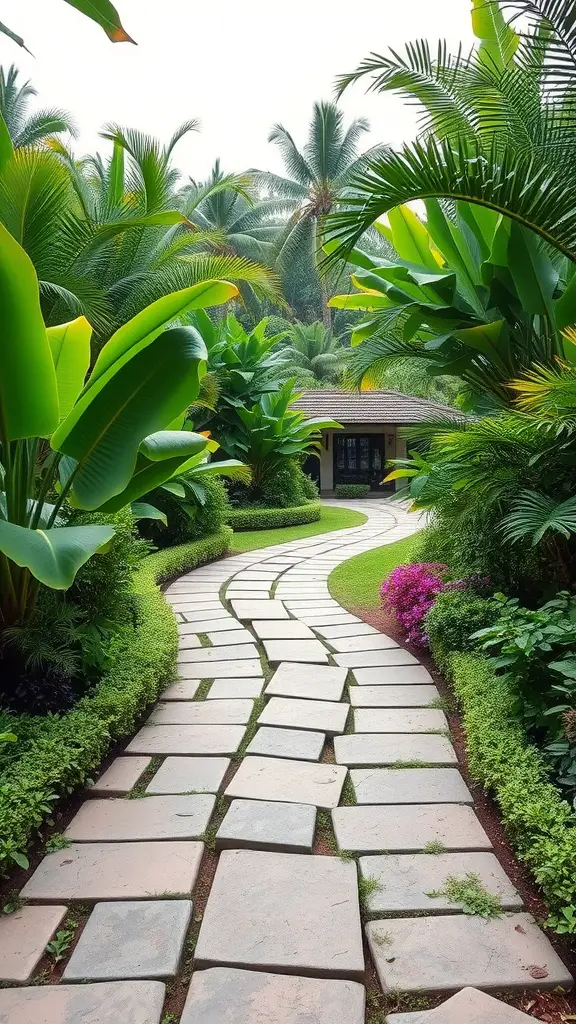
Tropical garden pathways are essential for navigating vibrant landscapes. This image features a stunning stone path meandering through lush foliage. The stones’ varied shapes and sizes create an organic feel, perfectly harmonizing with the surrounding plant life.
The pathway’s soft curves beckon you to explore. It draws you deeper into the garden’s captivating beauty. Vibrant tropical plants line the path, adding richness and dimension. Bright flowers provide splashes of color, creating a welcoming atmosphere. This path encourages you to stroll and uncover the garden’s secret treasures.
Garden pathways boost visual appeal and improve usability. They establish clear routes for easy movement through your plants. When planning your tropical garden, design pathways that guide visitors on an engaging exploration. Highlight the stunning plants and the garden’s tranquil atmosphere.
Utilizing Water Features for Serenity
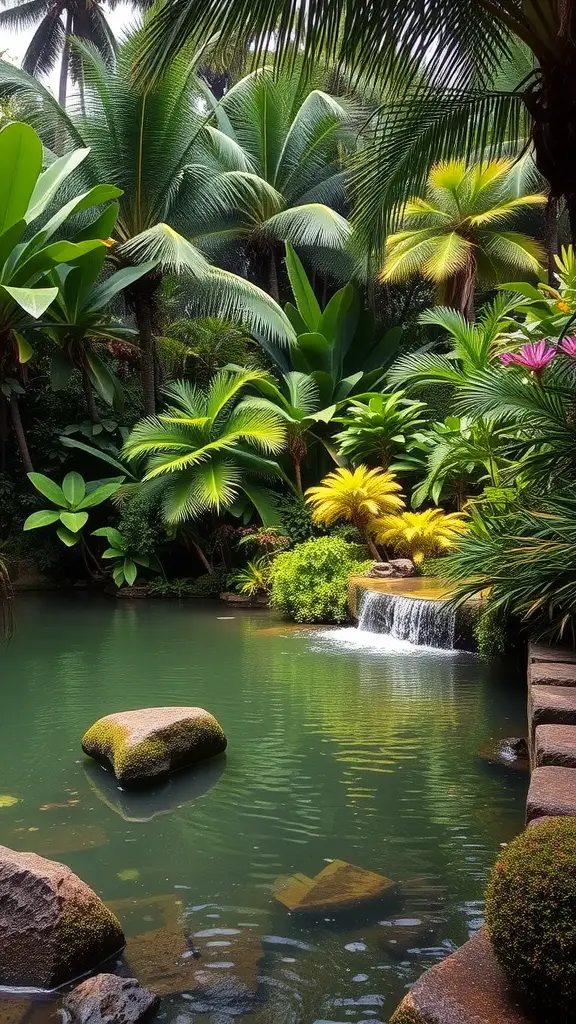
Water features elevate tropical gardens into serene havens. This image showcases a tranquil pond mirroring the vibrant, surrounding foliage. The soft cascade of a waterfall enhances the peaceful ambiance, encouraging relaxation.
Adding a pond elevates your garden’s natural charm. Local flora, like ferns and vibrant tropical blooms, elegantly surround the water. This creates a balanced and visually appealing landscape. Choosing suitable plants is key. They enhance the aesthetics and provide vital support for regional wildlife.
Think about incorporating smooth stones or larger boulders close to the water’s edge. These offer comfortable resting places for guests and enhance the natural aesthetic. The diverse heights and textures contribute to a richer, more layered garden design.
In 2025, water features remain essential for creating tranquil spaces. They captivate visitors and promote relaxation. Transform your tropical garden into a rejuvenating escape.
Creating Outdoor Living Spaces

Crafting outdoor spaces is a truly enjoyable endeavor. This image showcases a charming retreat enveloped in vibrant greenery, creating an appealing haven. The selected furnishings, including the wicker chairs, contribute a sense of coziness and relaxation.
Adding tropical plants elevates your space and fosters tranquility. Their bright blooms and lush foliage offer seclusion and visual appeal, crafting an ideal haven for unwinding.
Personalize your outdoor area with small tables and decorative touches. Think candles or vases. This invites people to gather. Enjoy morning coffee or evening conversations with friends. As the sun goes down, lighting, such as a hanging lantern, creates a relaxing atmosphere.
Finally, consider the layout. Position seating to encourage interaction and allow for smooth navigation. With thoughtful additions, your outdoor space can become an inviting haven in 2025.
Creating Lush Foliage Canopies
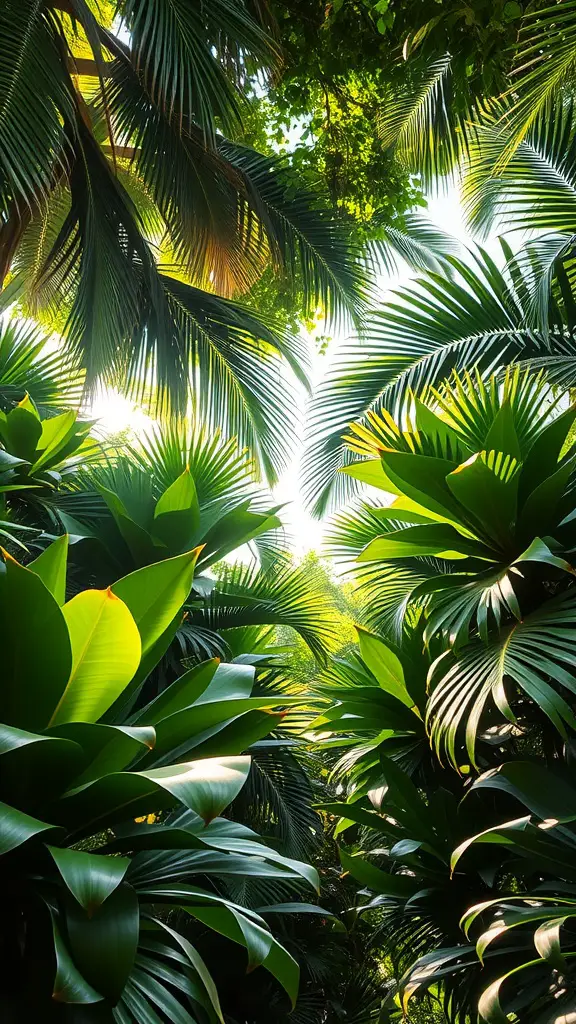
Picture yourself entering a vibrant tropical haven. Lush greenery surrounds you, seemingly stretching towards the heavens. This scene perfectly embodies dense foliage canopies. Diverse leaves form a breathtaking overhead spectacle. The dance of light and shadow enhances the depth, creating a tranquil getaway.
Crafting your tropical oasis? Focus on layering plants to mimic lush canopies. Incorporate towering palms and broad-leaved tropicals for height and form. Place them thoughtfully to form a natural green roof. This enhances visual appeal and provides cooling shade, transforming your garden into a relaxing escape.
A variety of greenery is essential. Use plants with different shapes and colors to boost visual interest. Think about pairing Monstera and broad-leafed Philodendrons with delicate palm leaves. This mix creates a vibrant scene that’s both engaging and inviting.
Finally, remember to add pathways. These should wind through the plants, encouraging exploration and revealing secret spots. Thoughtful planning will help you design a vibrant and welcoming tropical escape, mirroring the image’s captivating scene.
Incorporating Tropical Flowers for Color

Lush tropical gardens burst with vivid hues, where flowers reign supreme. Imagine a landscape alive with hibiscus and orchids. Their radiant reds, pinks, and yellows infuse energy and delight into any setting. These stunning blossoms transform your backyard into a personal paradise.
Elevate your garden with a vibrant mix of tropical blooms! Imagine the striking contrast of vibrant hibiscus alongside graceful orchids. This pairing ensures each flower shines, enhancing the garden’s overall tropical beauty. Consider this stunning combination for your 2025 garden update.
Remember the greenery! Big, verdant leaves amplify the flowers’ brilliance. They create an ideal setting, intensifying the vivid hues. Smart flower placement results in striking displays that captivate all eyes.
Adding tropical flowers goes beyond just beauty. These vibrant plants frequently draw butterflies and hummingbirds. This influx of wildlife enhances your garden’s vitality. The sounds and sights of these creatures create a welcoming and energetic atmosphere.
Incorporating Edible Plants and Herbs
Crafting a tropical garden is a delightful way to merge beauty with practicality. Picture yourself immersed in rich foliage, where colorful plants bring your outdoor area to life. The featured image showcases a stunning tropical garden, complete with banana trees laden with ripe, yellow fruit. This perfectly embodies the concept of integrating edible plants into your landscape.
Elevate your garden by integrating edible plants! This adds beauty and provides fresh ingredients for your cooking. Consider planting basil, mint, and cilantro near your tropical foliage. These herbs are simple to cultivate. They flourish in the same warm, sunny environment that benefits your tropical plants.
Think about incorporating vegetables like tomatoes or peppers. They integrate seamlessly into your garden design. Enjoy the fresh, homegrown flavor in your meals. Growing edible types provides a sustainable, natural food supply in your own backyard.
Consider companion planting! Combining herbs with specific plants naturally deters pests and boosts growth. Basil thrives alongside tomatoes, improving their taste and repelling unwanted insects.
When planning, prioritize accessibility. Ensure harvesting herbs and fruits is effortless. Smart layout choices significantly enhance your gardening enjoyment.
Transform your space into a thriving tropical edible garden! It’s a fulfilling and enjoyable way to connect with nature. Plus, you’ll have fresh ingredients right at your fingertips. Put on your gardening gloves and design your own vibrant, productive paradise today!
Choosing the Right Soil for Tropical Plants
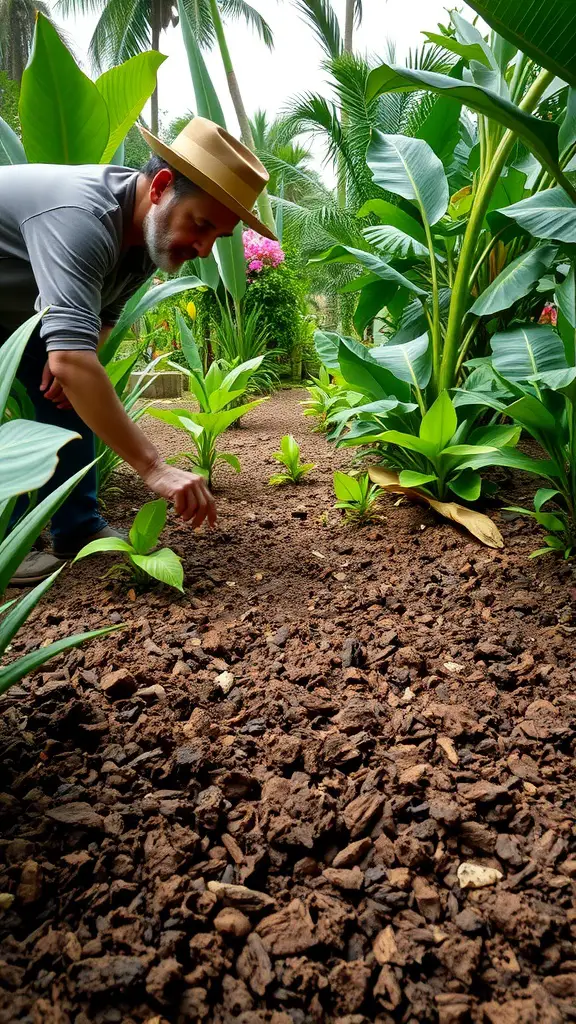
Choosing the correct soil is vital for a thriving tropical garden. Our image shows a gardener carefully working the soil, amidst vibrant tropical plants. This scene highlights the importance of nurturing the earth, which directly impacts plant health and growth.
Tropical plants flourish in nutrient-rich, well-drained soil, replicating their native habitat. Adding organic materials such as compost improves soil quality and boosts fertility. The image shows a gardener probably getting ready to plant or nurture young tropical plants. They’re ensuring ideal conditions for healthy growth.
Choose soil that holds moisture effectively, but avoids waterlogging. A blend of peat, perlite, and coconut coir is often ideal for these gardens. This mix ensures proper drainage and delivers essential nutrients for robust plant growth.
When designing your tropical oasis, soil health is key. Like the gardener pictured, prioritize soil care. Analyze its pH and nutrient content to match your tropical plants’ requirements. Healthy soil guarantees a flourishing garden, bursting with vivid hues and vitality in your yard.
Lighting Techniques to Enhance Nighttime Beauty
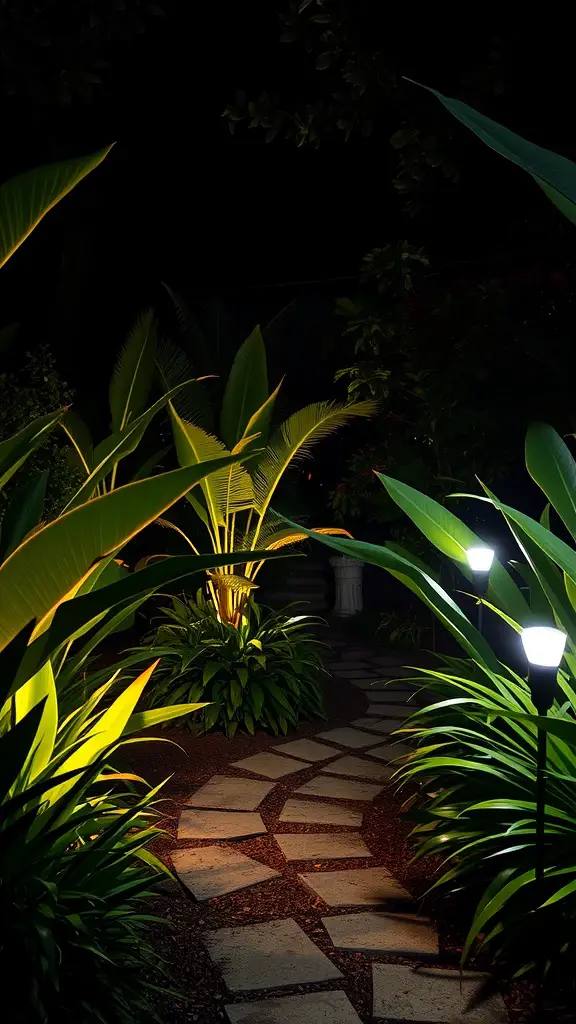
Crafting a tropical garden involves more than just colorful plants. Strategic lighting can turn your outdoor space into an enchanting escape after sunset. The picture displays a well-lit path surrounded by vibrant foliage, perfect for a peaceful evening walk. This 2025 update emphasizes energy-efficient and smart lighting solutions for a modern tropical paradise.
Gentle lighting accentuates the garden’s lush foliage and intricate stonework, showcasing its inherent charm. This illumination improves visibility and introduces a cozy, inviting feel. Strategically positioned lights along walkways offer a warm welcome, effortlessly guiding visitors through the garden in 2025.
Combine uplighting with pathway lights for a stunning effect. Uplights highlight plants, casting dramatic shadows and adding depth. This brings your garden to life after dark. Pathway lights clearly define walkways, ensuring safety and boosting the garden’s beauty.
Consider the desired ambiance when designing your lighting scheme. Gentle, warm illumination fosters a welcoming atmosphere. Conversely, cooler tones can evoke a contemporary aesthetic. Explore various angles and brightness levels to achieve the ideal harmony for your tropical haven.
Creating Microclimates Within the Garden

Crafting microclimates in your garden in 2025 allows you to convert any area into a thriving, exotic haven. This image showcases a lively setting with a wide array of plants, including striking palms and vibrant bromeliads. The contrasting light and shadow generate varied temperature zones. This makes cultivating a diverse range of plant species simpler than ever.
Leverage existing elements like mature trees or buildings to create microclimates. A large tree, for example, offers both vertical interest and valuable shade, cooling the immediate environment. This enables you to cultivate both sun-loving and shade-tolerant plants in close proximity.
Plant arrangement is also key. Position larger plants, such as palms, thoughtfully. This creates protected zones. These zones shield smaller plants. They guard against strong winds and intense sunlight. This ensures a better growing environment.
Also, think about incorporating natural stone pathways or features, like those pictured. These additions visually direct attention throughout your garden and effectively store solar heat during the day. This stored heat is then gradually released at night, which helps to stabilize the local temperature.
Elevate your microclimates’ beauty by incorporating diverse foliage colors and textures. The vibrant greens and bold reds in the picture exemplify how varied plants can foster an energetic ambiance. Select plants that harmonize to create a garden that feels unified and welcoming.
Selecting Drought-Resistant Tropical Plants
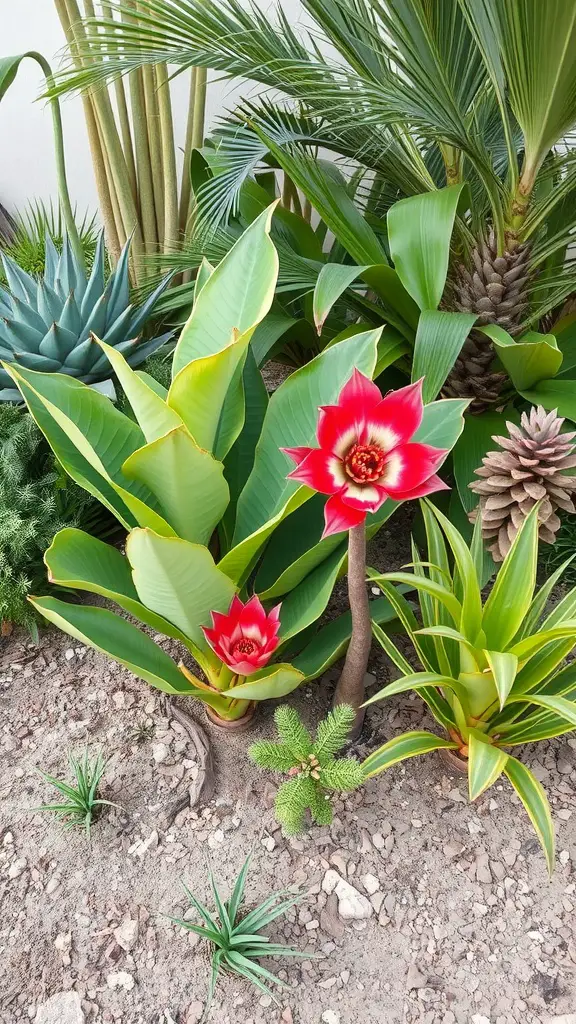
Crafting a tropical garden? Select plants that flourish in hot climates and require minimal watering. The picture displays a stunning array of colorful tropical plants. Notice the dense leaves and vivid blossoms that can truly enhance your garden’s appeal.
These expansive green leaves are beautiful and vital for soil hydration. Plants like these offer structure and shade, aiding nearby plants in water retention. See the vibrant red flowers emerging? They introduce color and attract pollinators, enhancing your garden’s ecosystem.
Observe the diverse textures and forms, perfect for captivating visuals. Agave and similar succulents thrive in arid areas, needing little water after settling in. Combining these drought-tolerant plants with those needing more water ensures a vibrant garden with less upkeep.
Therefore, when designing your tropical oasis, think about including these robust plants. They enhance beauty and variety while promoting eco-friendly gardening practices.
Incorporating Natural Stone Elements
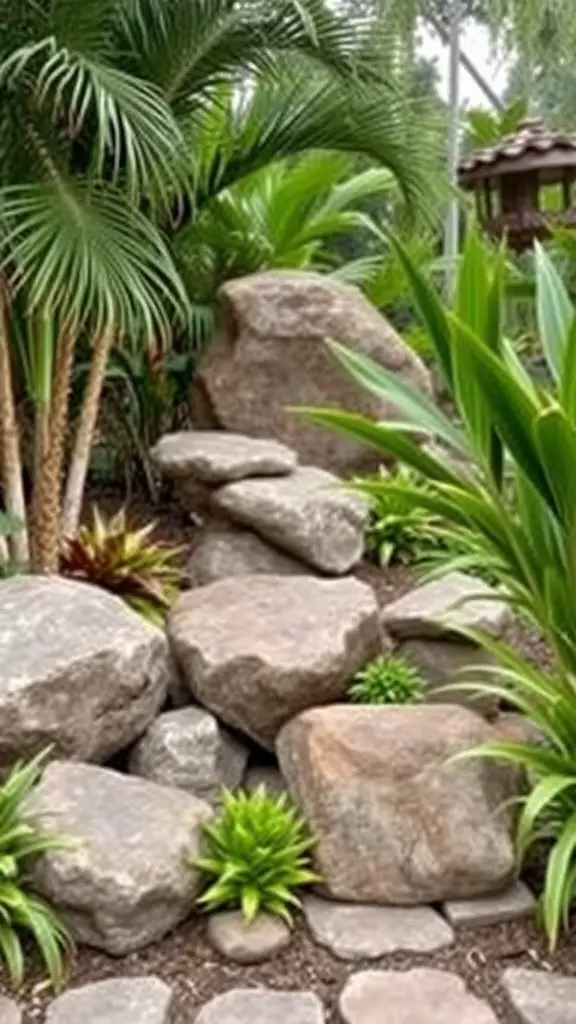
In 2025, incorporating natural stone is key to crafting stunning tropical gardens. The blend of vibrant plants and textured stone provides an appealing, natural harmony.
The image showcases a beautiful stone arrangement integrated with lush greenery. The stones, diverse in size and form, create captivating visual appeal. This layered design enhances the vibrancy and dynamism of any garden space.
Stone pathways, similar to those pictured, offer both practicality and aesthetic appeal, enhancing the tropical ambiance. They direct guests through the garden, seamlessly blending with the environment.
Adding these features improves drainage and strengthens the soil. They also need very little upkeep compared to many plants. This lets you appreciate your tropical garden’s beauty with ease.
Using Vertical Gardening Techniques
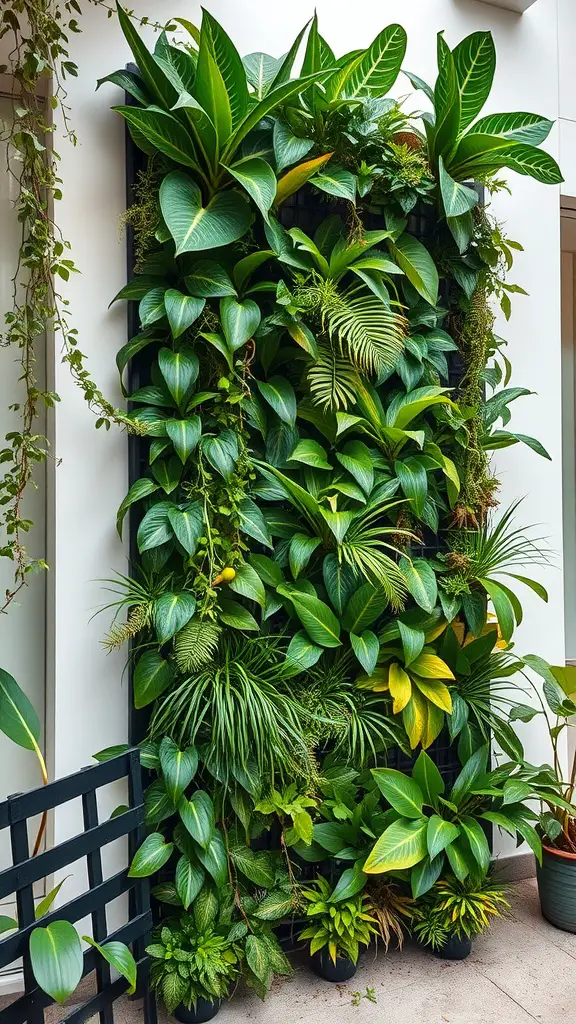
Vertical gardens offer a delightful and innovative approach to incorporating plants into your environment, particularly within a tropical garden setting. This image presents a flourishing vertical garden, abundant with verdant plants, forming a captivating green wall. Envision converting a simple wall into a dynamic showcase that enhances aesthetics and purifies the air.
This arrangement showcases diverse tropical plants, selected for their distinctive forms and vibrant hues. Lush greens, punctuated by sporadic yellow foliage, enhance visual appeal and tactile interest. A vertical design optimizes space, fostering a tranquil environment perfect for unwinding.
Vertical gardens excel because they adapt to any space, even tiny ones. Install them effortlessly in backyards, on balconies, or inside your home. This adaptability is ideal for anyone wanting to improve their surroundings, regardless of yard size.
Choose plants wisely for your vertical garden, considering their compatibility. Blend cascading vines with bigger leaves for an appealing look. Note each plant’s light needs; some flourish in sunshine, others in shadow. This careful balance ensures a vibrant and healthy vertical garden in 2025.
Maintaining a thriving vertical garden requires consistent care. Watering frequency depends on your plant selection and local weather. Consider a simple irrigation setup or self-watering containers to simplify maintenance.
Creating a Tropical Herb Garden
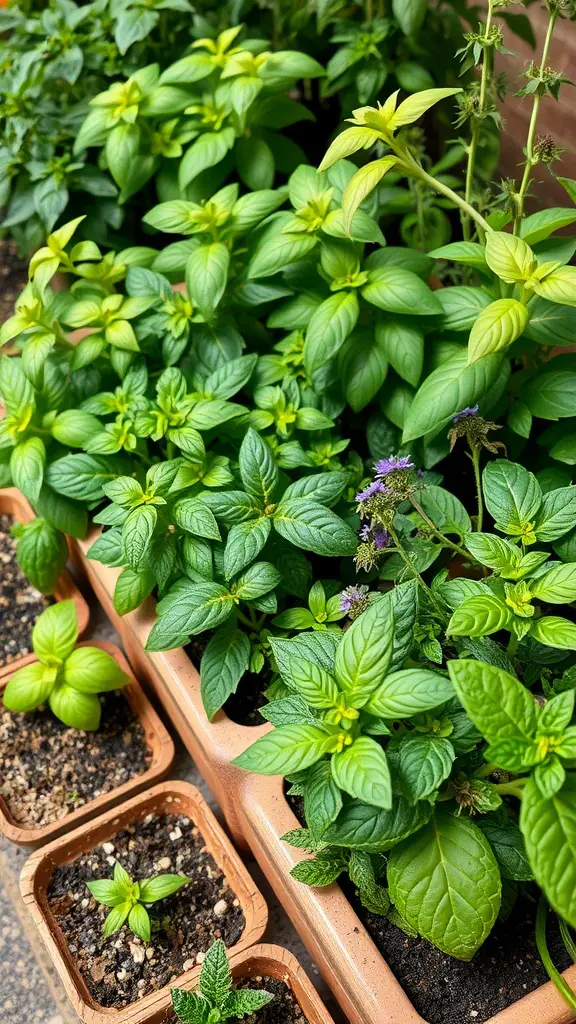
Planning a tropical herb garden? Your search ends here! This image displays a lively assortment of herbs, perfect for enhancing your culinary creations. From basil to mint, these plants flourish in sunny, warm environments.
Begin by selecting your preferred herbs. Basil remains a top pick, celebrated for its delightful scent and culinary adaptability. Mint offers a revitalizing flavor, ideal for beverages and sweets. For a bolder taste in your dishes, think about incorporating cilantro and lemongrass.
Cultivate your herbs in soil with excellent drainage. Make sure they receive ample sunlight. Grouping your plants enhances visual appeal and simplifies care. Remember to water them consistently; tropical herbs thrive in moist conditions!
Imagine the joy of harvesting fresh herbs as your garden thrives. Pluck a few leaves to elevate your salads or sauces. It’s a fantastic way to enrich your cooking and savor the charm of your tropical oasis.
Building Cozy Nooks with Seating
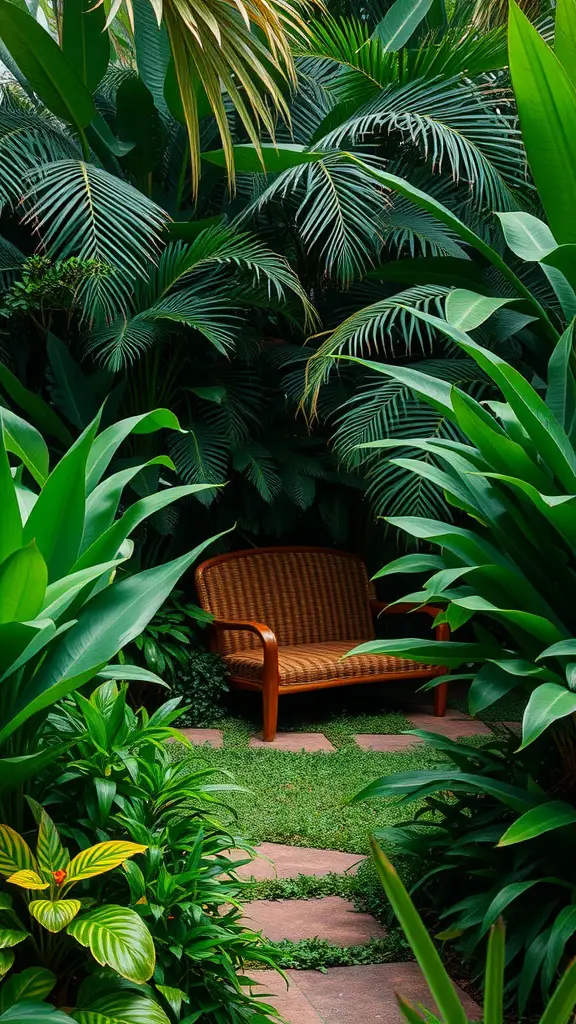
Crafting inviting retreats within your tropical garden involves merging comfort and nature seamlessly. The image showcases a charming wooden bench nestled amidst vibrant foliage, providing an ideal sanctuary. This seating arrangement encourages relaxation, allowing you to fully appreciate the surrounding natural splendor.
Lush greenery is key to this design’s success. Towering palms and colorful plants foster a sense of seclusion and peace. This area feels like a secret escape, perfect for reading or sipping coffee. Add plush cushions for extra comfort, making your nook even more appealing.
Garden pathways, similar to these stone steps, expertly guide you to tranquil areas. They provide structure and draw your gaze further into the garden’s heart. For seating, consider diverse materials, but natural wood enhances the tropical ambiance perfectly. Combine it with vibrant plants for added visual appeal.
Elevate your tropical garden in 2025 by adding inviting cozy nooks. These spaces offer more than just visual appeal. They provide tranquil retreats to savor the lush environment.
Embracing Seasonal Changes in Plant Selection
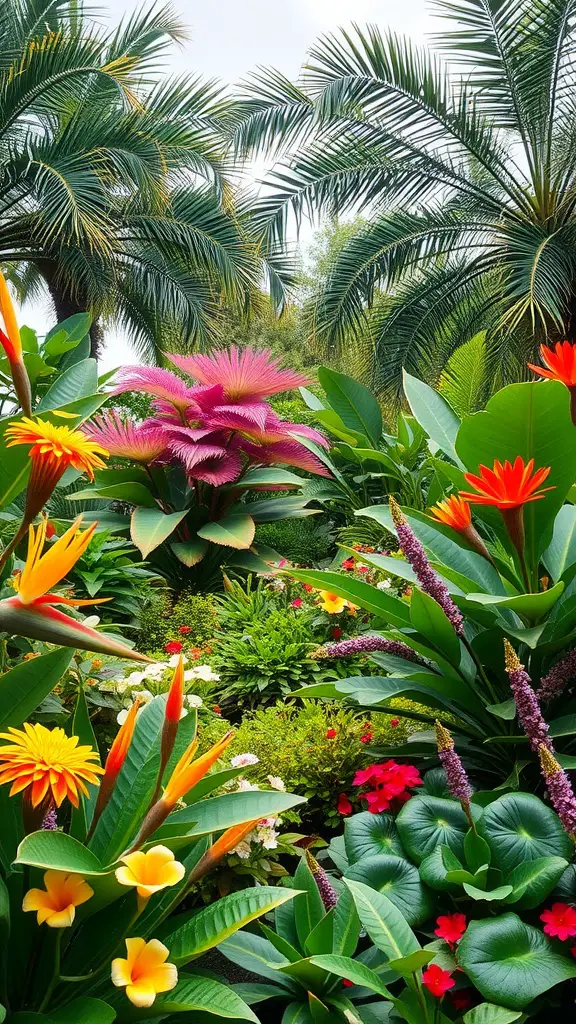
Crafting a tropical garden involves more than just picking bright plants. It’s about knowing how seasons impact your choices. This image displays a vibrant scene with colorful blooms and lush greenery. Each plant adds its own unique flair, highlighting the diverse options in tropical gardening.
Choose plants based on their bloom times. For example, bird of paradise flowers excel in summer. Other plants do better in cooler seasons. This diversity ensures your garden has vibrant colors year-round. It stays interesting and full of life.
Consider how certain plants shine during particular seasons. The vibrant pink bromeliad at the image’s center is eye-catching, perfect for summer arrangements. Smaller flowering plants can add pops of color among larger greenery, creating depth and visual interest.
Watering and plant care change with the seasons. Adjust your gardening to match. Tropical plants need more water when growing. They need less when dormant. This helps your garden stay healthy. Plants thrive year-round with this knowledge.
In summary, adapting your plant choices to the seasons results in a vibrant and stunning tropical garden. Selecting diverse plants with staggered bloom times ensures a lively, year-round display, captivating all who experience its charm.
Designing with Color-Themed Plantings
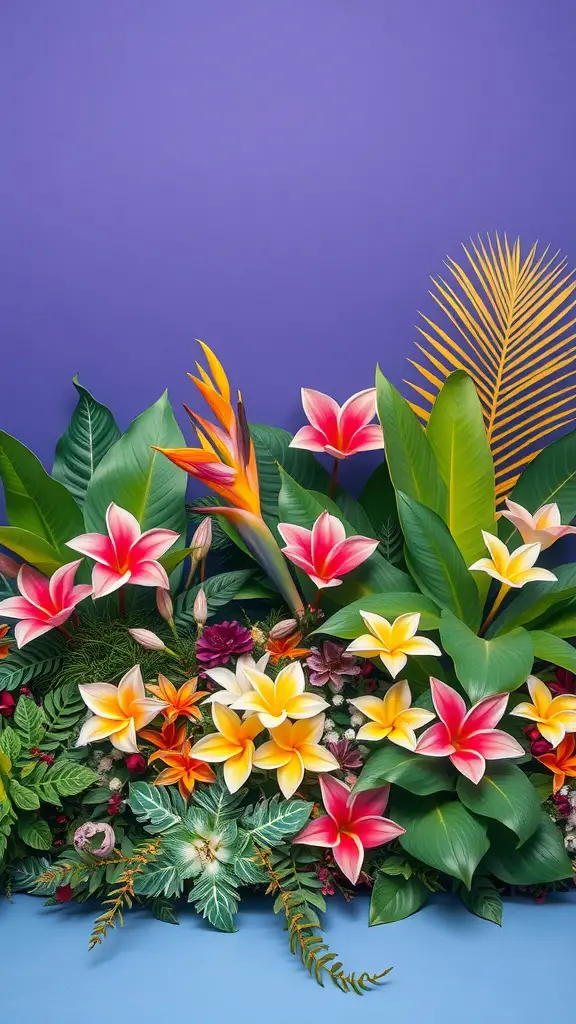
Color is key to a vibrant tropical garden. Bright flowers and leaves create a cheerful, inviting space. Picture a garden bursting with colorful blooms and rich greenery. It beckons you to discover its hidden beauty.
This vibrant image showcases a stunning array of tropical blooms, including heliconias and plumerias. Their bright yellow, pink, and orange hues pop against the lush, dark green foliage. This vivid color combination creates a visually captivating scene, promoting feelings of tranquility and happiness. Updated for 2025, this image captures the timeless beauty of tropical flora.
Design your 2025 garden with a focused color palette for a harmonious look. Combine complementary colors for a vibrant display. Use similar shades for a calming atmosphere. Explore diverse textures and tones. The dance of light and shadow will energize your tropical garden.
Adding seasonal plants brings dynamic variety to your garden. As certain flowers finish blooming, others will emerge, keeping your garden lively all year. Group plants with similar hues for a unified aesthetic. Alternatively, scatter bursts of color for a more whimsical and fun garden design.
Utilizing Ground Cover Plants for Moisture Retention

Ground cover plants are essential for retaining moisture in a tropical garden. The image displays a vibrant array of green leaves, featuring both ground covers and taller plants. These low-growing plants are visually appealing and help keep the soil moist, preventing it from drying out. They are a key component for a thriving tropical landscape in 2025.
Selecting the perfect ground cover is key for a vibrant tropical garden. Consider moisture-loving plants like hostas and ferns, showcased in the image. These plants naturally spread, forming a thick, protective layer. This layer significantly reduces water loss from the soil. Enjoy less watering and a healthier garden!
These plants also boost your garden’s well-being. They combat soil erosion and naturally control weeds. This keeps your tropical paradise neat and attractive. The varied textures and green hues add visual appeal. Your garden will feel vibrant and welcoming.
Using ground cover plants is a simple method to boost your garden’s beauty and sustainability. Prioritizing moisture retention helps establish a healthy environment for all your plants to thrive in 2025.
Harmonizing Hardscapes with Nature
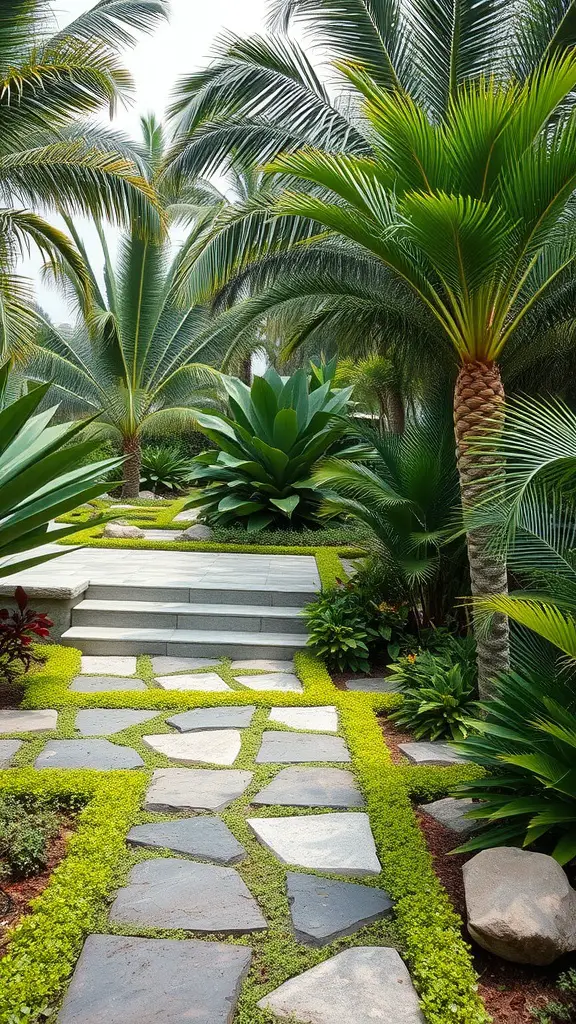
Crafting a tropical garden in 2025 involves seamlessly merging constructed features with nature. This image highlights a peaceful path bordered by vibrant plants. It demonstrates the stunning harmony achievable between stone and foliage.
Stepping stones form a distinct pathway, leading visitors through the garden. These stones are practical and enhance the garden’s texture and charm. The contrast of the gray stones against the lush green ground highlights the area’s natural appeal.
Observe how the towering palm trees and expansive foliage generate a feeling of intimacy, enhancing the space’s allure. This balance of solid structures and gentle greenery inspires discovery while preserving a serene ambiance.
Integrating elements such as garden paths and steps elevates both navigation and visual appeal. This design strategy promotes exploration, inviting you to discover diverse perspectives and plant compositions throughout your garden in 2025.
The ultimate aim is crafting a garden seamlessly connected to nature. Thoughtful material and plant choices will create a space that feels both natural and beautifully designed. This makes it a true pleasure to enjoy.
Designing Rain Gardens for Water Management
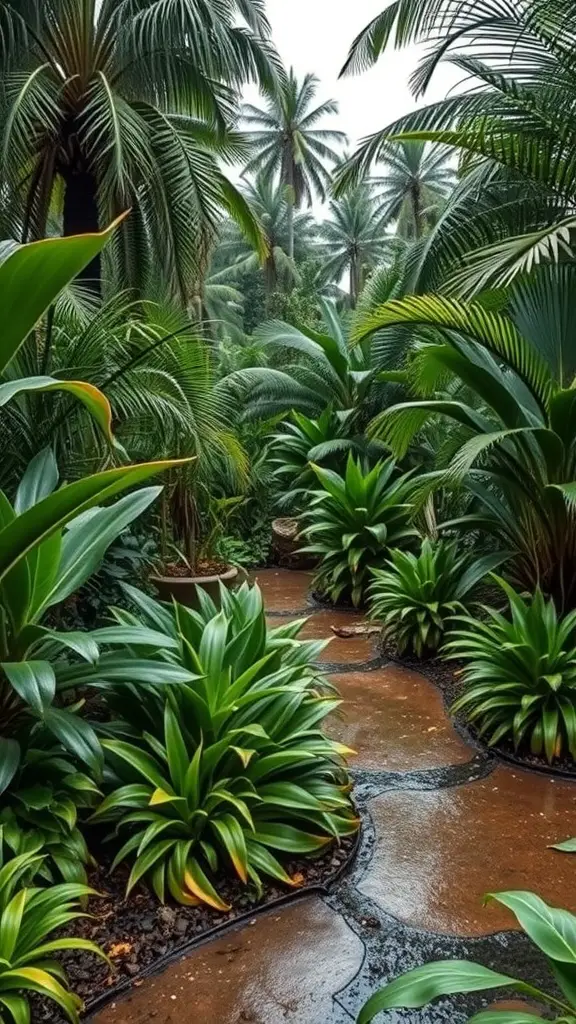
Rain gardens offer an intelligent solution for water management, enhancing the aesthetics of your tropical oasis. This image presents a picturesque path bordered by lively green foliage, inviting you into a flourishing environment. These gardens effectively collect rainwater, enabling absorption into the soil instead of drainage runoff.
Begin your rain garden by identifying a spot where rainwater gathers easily. Choose plants that flourish in damp environments. As the image shows, tropical varieties such as ferns and diverse palms are excellent choices for these gardens.
Stone pathways, such as this example, expertly manage water runoff and enhance visual appeal. The curved design encourages discovery while efficiently controlling water distribution across the garden in 2025.
Lastly, think about your rain garden’s layers. Varying plant heights improve drainage and add visual interest. Careful planning ensures your rain garden is functional and a stunning addition to your tropical landscape.
Creating Wildlife-Friendly Spaces
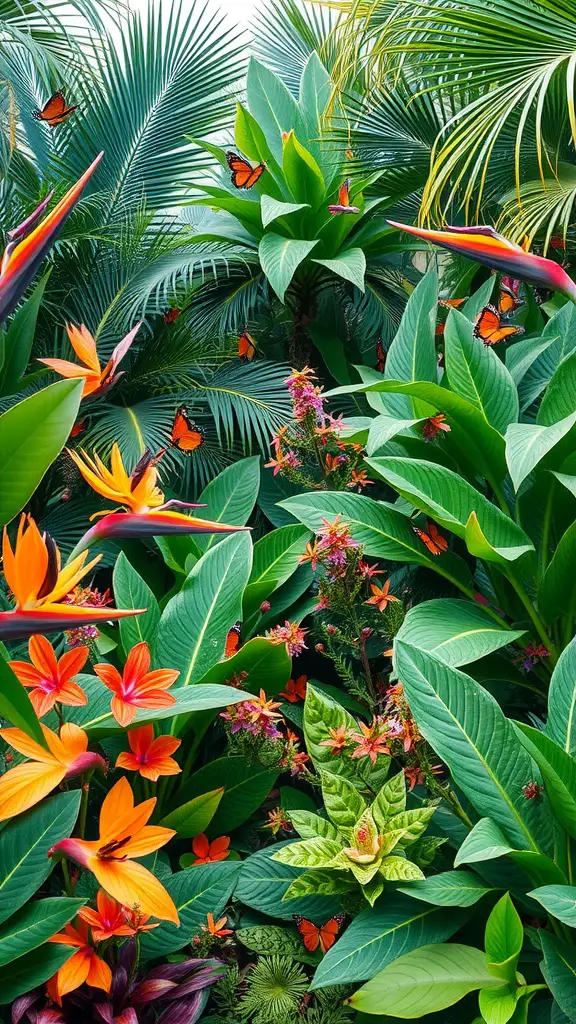
Crafting a tropical garden is both enjoyable and fulfilling. Prioritize spaces that attract local wildlife. The stunning image showcases a vibrant collection of plants. Butterflies gracefully flutter among them. This creates a beautiful scene and a thriving habitat for diverse wildlife.
Elevate your garden’s allure by including butterfly-attracting plants. The vibrant orange blossoms and lush foliage in the picture demonstrate how colorful flowers attract these vital pollinators. Think about planting native species that offer nectar and serve as host plants for caterpillars to flourish.
Creating garden layers is key for a thriving ecosystem. Towering palms and expansive leaves offer vital shelter for birds and small creatures. The thick foliage in the picture provides an ideal refuge for animals seeking protection. Enhance your garden’s appeal by incorporating diverse plant heights and varieties. This fosters a more welcoming habitat for wildlife.
Remember to include water features! A small pond or even a simple birdbath can draw diverse wildlife. The beauty of water, alongside colorful plants, creates a dynamic garden ecosystem. The active presence of butterflies and other creatures transforms your garden into a vibrant haven.
Incorporating Exotic Fruit Trees
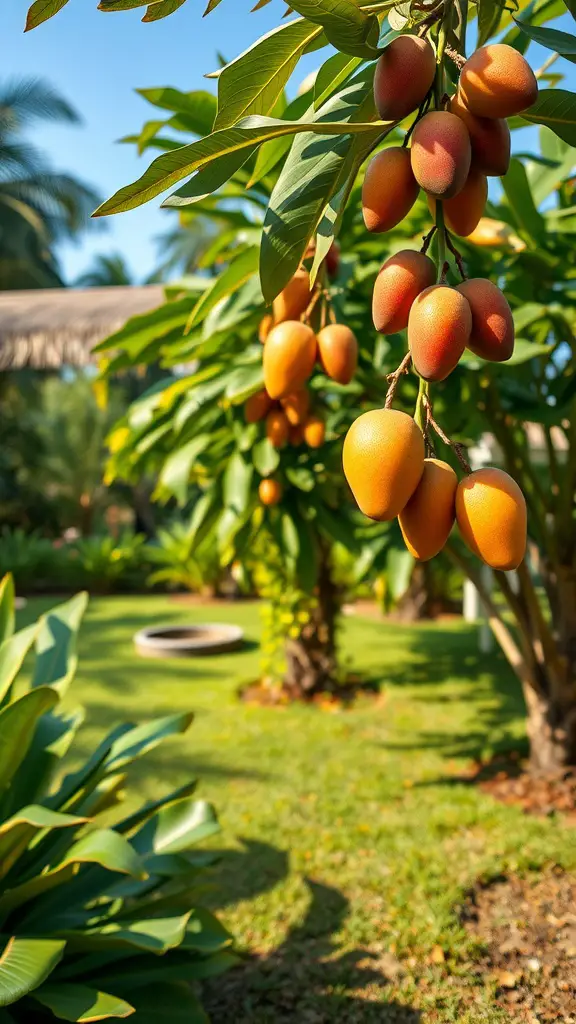
Transform your garden into a tropical paradise with exotic fruit trees. They create a lush and inviting atmosphere. Picture yourself strolling through your garden, admiring the colorful fruits dangling from the branches. These trees offer both aesthetic appeal and delectable, homegrown produce.
This image showcases trees laden with vibrant fruit, probably mangoes. The fruit’s warm hues provide a stunning contrast against the lush, dark green foliage, resulting in a captivating view. These trees can become a central attraction in your garden, instantly grabbing attention and initiating discussions.
Planning your tropical garden? Prioritize the fruit trees you desire. Assess their individual sunlight and space requirements carefully. Mango trees, for example, flourish in full sun. Position them accordingly. Integrate them seamlessly with other tropical plants for a harmonious design.
Growing exotic fruit trees offers a unique experience. Consistent watering and strategic pruning are key for their well-being. The reward? Fresh, homegrown fruit at your fingertips. Envision crafting delicious smoothies and desserts using your own garden’s bounty!
Elevate your garden in 2025 by adding unique exotic fruit trees. These trees enhance your landscape’s beauty. Plus, they provide delicious fruits for your cooking adventures. Bring vibrant colors and exciting flavors to your outdoor space with these stunning trees.
Fostering Community Through Shared Garden Spaces

Gardens in 2025 are evolving into vital community spaces. This tropical garden scene showcases vibrant plants, welcoming walkways, and smiling people. Its design fosters neighborly connections and strengthens community bonds.
Community gardens, such as the one pictured, foster a sense of togetherness. People collaborate on planting, tending, and harvesting. This shared activity sparks conversations and teamwork. Working side-by-side strengthens community bonds that extend far beyond the garden walls.
Moreover, the flourishing greenery provides a stunning setting for local gatherings. Expect to see workshops focused on modern gardening techniques, innovative cooking methods, and cutting-edge sustainability practices. These events will foster stronger community connections. Sharing gardening secrets or enjoying a collaborative meal with freshly harvested ingredients will build lasting friendships.
Shared gardens cultivate responsibility among participants. Each person helps care for the plants. This ensures the garden stays vibrant and fruitful. This collective effort strengthens bonds and builds community pride in 2025.
In 2025, these gardens remain vital spaces for growth. They foster both plant life and strong community bonds. Working the land together builds cooperation and a sense of unity.
Incorporating Art and Sculptures
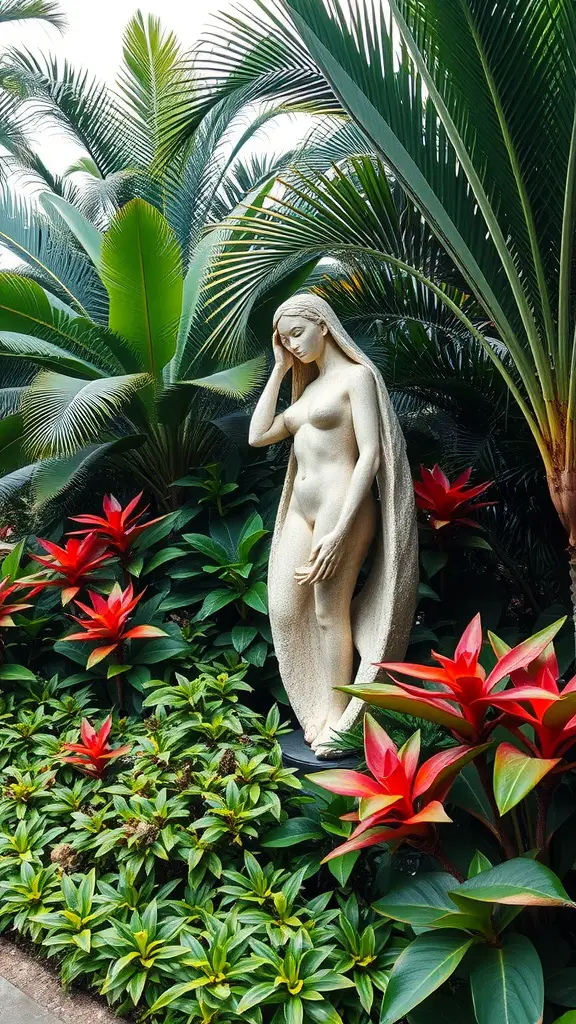
Tropical garden designs benefit greatly from art and sculptures. These elements introduce unique focal points, elevating the garden’s aesthetic appeal. This image features an elegant sculpture nestled among vibrant flora, demonstrating the seamless blend of art and nature in a tropical setting.
The sculpture’s figure exudes peacefulness, enhancing the garden’s calm ambiance. This harmony between nature and art draws the eye and encourages reflection. Incorporating sculptures crafted from sustainable materials can boost your garden’s eco-friendliness in 2025.
In 2025, art selection should complement your garden’s flora. Imagine vibrant red blooms and lush green leaves setting the stage. This dynamic backdrop amplifies the sculpture’s refined beauty. Pick art that mirrors your garden’s unique character – be it playful, contemporary, or classic.
Strategic placement is crucial. Position sculptures along paths or near benches to foster relaxation. This attracts attention and motivates exploration. Thoughtful art elevates your tropical garden into a captivating sanctuary.
Using Textured Plants for Visual Interest
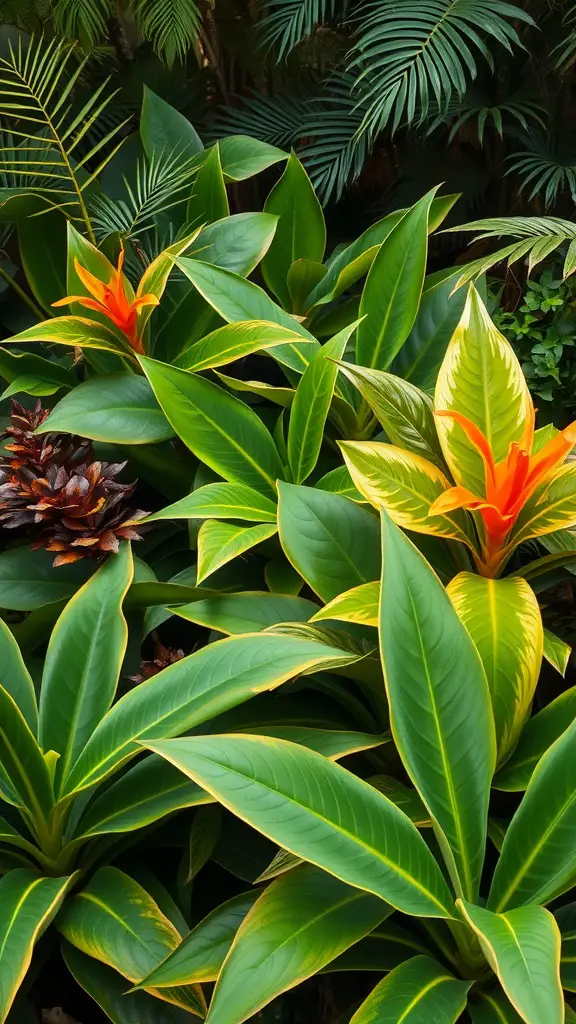
Crafting a tropical garden? Focus on the allure of diverse plant textures. A mix of forms and dimensions will energize your space. Think about it: expansive, shiny leaves build visual richness, and vibrant hues instantly draw the eye.
This photo showcases a blend of rich green hues and striking orange tones, set against a background of deeper, shadowy leaves. This color contrast significantly boosts the garden’s visual charm. Plants with diverse textures, such as these, offer visual interest and build depth, naturally guiding the viewer’s gaze.
Using diverse plants with contrasting textures creates eye-catching focal points in your garden. Observe how the vibrant orange blossoms pop against the sleek, green foliage. This layering technique enhances depth and interest, transforming your garden into a welcoming space.
Furthermore, incorporating plants with distinctive leaf forms introduces dynamic visual interest. For example, elongated, pointed leaves interact with light uniquely. This creates shifting patterns of shadows and highlights as the day progresses.
Elevate your tropical garden by choosing plants with diverse textures. This creates a lively and immersive experience. When designing your garden, prioritize texture combinations for a captivating result.
Incorporating Seasonal Blooms
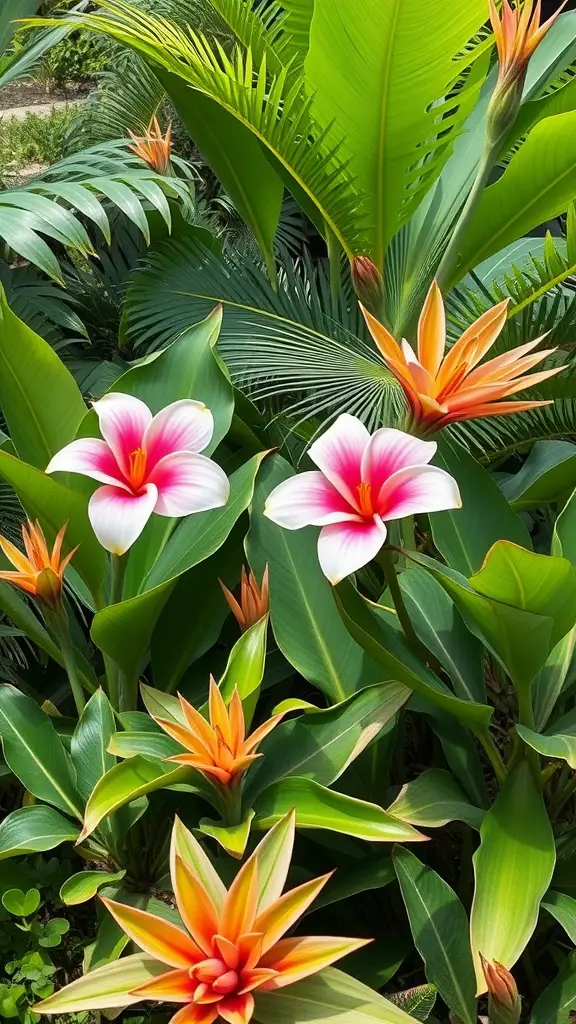
Tropical gardens in 2025 are revolutionized by seasonal blooms. These vibrant flowers dramatically change the landscape. The picture displays bright blossoms among rich greenery. Vivid pinks and oranges capture attention and energize the environment.
Seasonal flowers bring vibrant color and draw in vital pollinators. Butterflies and bees are naturally attracted to these blossoms, boosting your garden’s health. By planting diverse flowers with staggered bloom times, you ensure continuous color and life throughout the year.
Think about pairing vibrant, exotic blooms with plants boasting unique textures. This strategy adds dimension and captivates the eye. Imagine lush, verdant foliage serving as a stunning canvas, highlighting the brilliance of those radiant flowers!
Designing with Climate Considerations
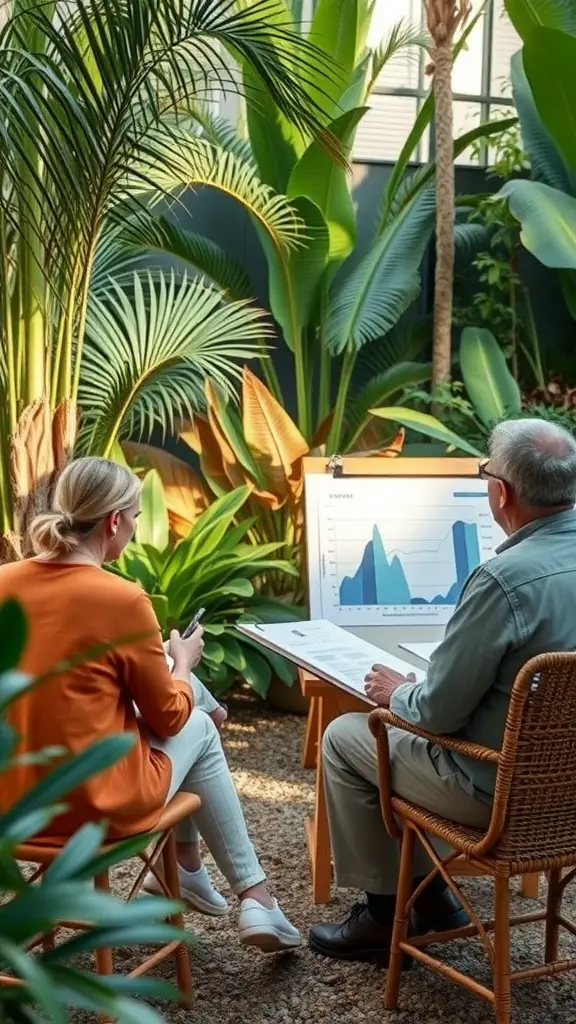
Tropical garden design in 2025 prioritizes climate. The photo features two individuals planning amidst vibrant, lush foliage. This setting perfectly supports diverse tropical plants. These plants flourish in consistently warm and humid environments.
Leveraging climate data empowers smarter plant choices. The image’s chart reveals growth trends, guiding your garden’s plant selection. Grasping local weather nuances ensures you pick species that thrive, not just survive. This knowledge leads to a flourishing and resilient garden.
Effective water management is key for tropical gardens. Tropical plants typically need more hydration in warmer regions. Consider eco-friendly solutions like collecting rainwater. This benefits your garden and helps preserve precious water resources.
Finally, think about your garden’s layout and its impact on temperature and humidity. Position larger plants carefully to offer shade and establish a microclimate that helps smaller plants thrive. Watching the sun and shadows throughout the day is crucial for effective planning.
Integrating Tidal and Coastal Elements

Crafting a tropical garden? Focus on capturing the essence of coastal and tidal landscapes. The picture showcases a vibrant green space with a tranquil water element, embodying this concept beautifully. The key is a seamless integration of flora and water features.
Big, bright leaves and tropical palms perfectly capture a coastal vibe. They enhance visual appeal and offer a feeling of coolness and relaxation. Adding smooth stones and water features brings in a natural element, resembling the beach.
Imagine stepping stones that appear to float on water, beckoning you to explore. This design element transforms your garden into an interactive and captivating space. It encourages leisurely strolls, allowing you to fully appreciate the garden’s distinct beauty. Enhance the coastal ambiance by incorporating natural elements such as driftwood or seashells.
Blend these features to design a revitalizing and welcoming tropical escape. Enjoy nature’s beauty while relaxing in your backyard. Create a serene sanctuary at your own home.
Encouraging Sustainability with Native Plants
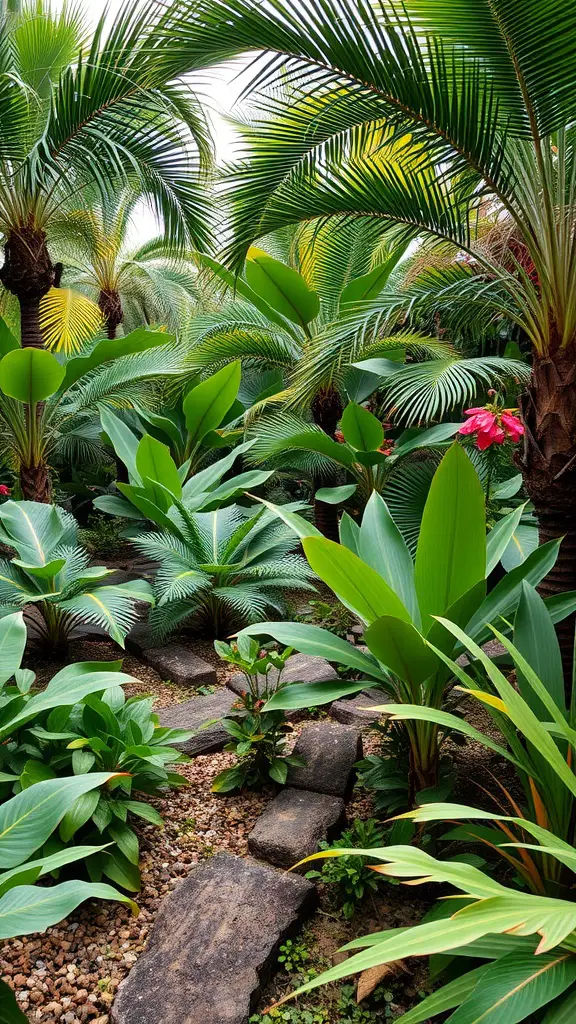
Step into this vibrant tropical oasis, where nature’s artistry unfolds through lush greenery and diverse textures. This garden champions sustainability, showcasing primarily native flora. These plants create vital habitats for local fauna and minimize reliance on harmful chemicals.
Imagine a tranquil stone path, effortlessly blending beauty with nature. It’s simpler than you think to design a peaceful, walkable area that also boosts local wildlife. Choosing native plants ensures easy upkeep and aligns perfectly with your region’s climate. This translates to reduced water usage and a greener, more eco-friendly garden.
Blending palms with diverse broad-leaved plants boosts visual charm. It also aids local pollinators such as bees and butterflies. This garden offers a welcoming vibe and fosters a thriving ecosystem. It’s a prime illustration of sustainable design principles for 2025.
Creating a Zen Tropical Retreat

Picture yourself entering a peaceful haven. You’re embraced by vibrant plants and calming water elements. This tropical garden design promotes relaxation and focus. Palm trees sway softly, their bright leaves adding color against the blue sky.
At the heart of this sanctuary lies a serene water feature. The soft, trickling sound of the fountain fosters a tranquil environment. It’s an ideal place for quiet reflection or relaxing after a busy day.
Beyond the refreshing water feature, seating selection is crucial. Relaxing lounge chairs invite you to unwind and appreciate the surrounding scenery. This outdoor area perfectly combines nature with contemporary design, creating a perfect getaway.
Lush greenery envelops the seating space, amplifying the tropical ambiance. Carefully selected plants with broad leaves and vivid hues create a visually stunning and thriving ecosystem. The garden’s serene atmosphere is almost palpable, inviting relaxation and peace.

